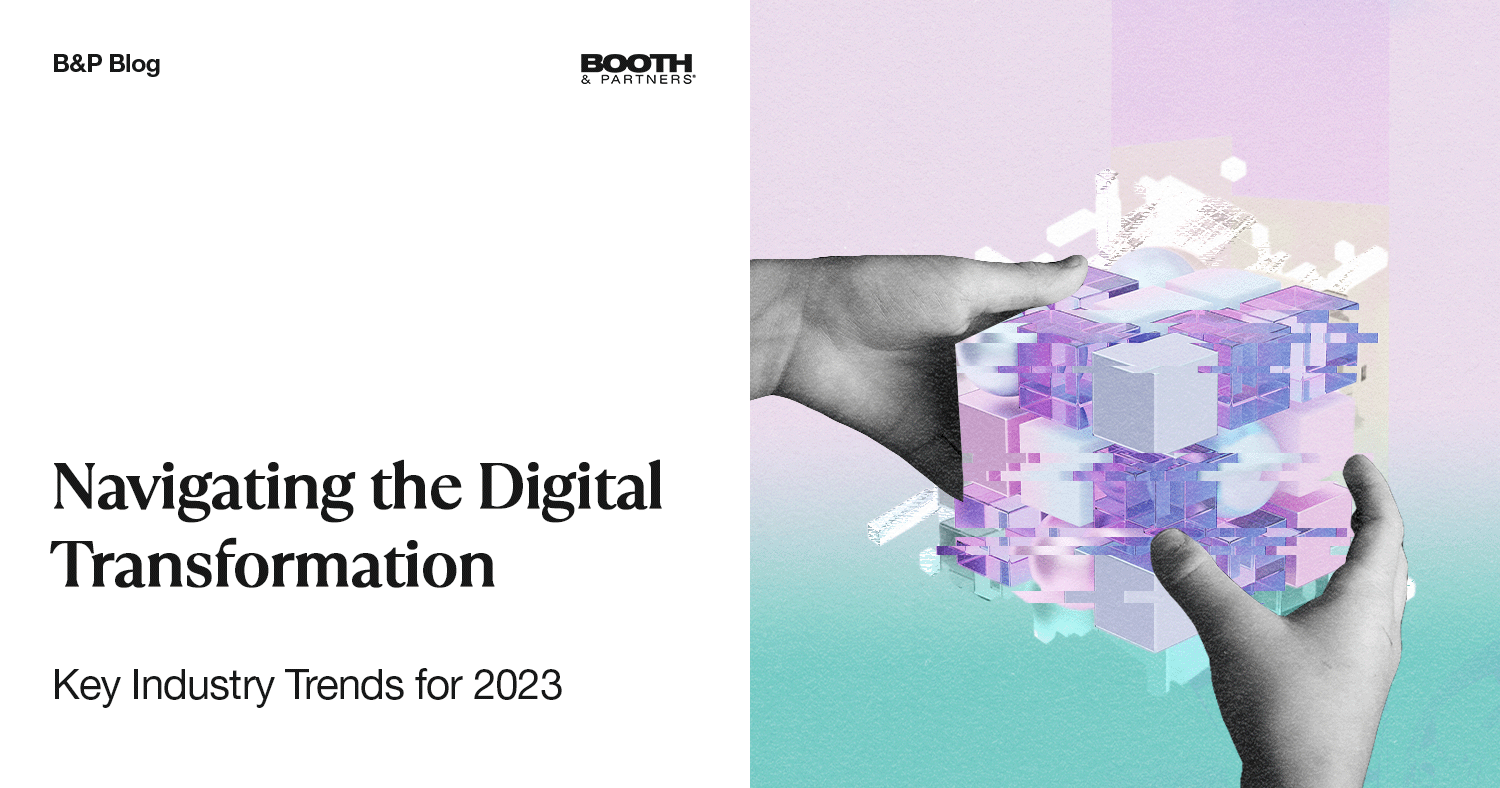Navigating the Digital Transformation: Key Industry Trends for 2023

As we approach 2023, it’s impossible to ignore the rapid pace at which the digital landscape evolves. Every day, new technologies emerge, businesses adapt, and industries transform. It is an extraordinary period of transition and opportunity.
Digital transformation has become an essential factor in the success of many businesses, and there are no signs of this trend slowing down anytime soon. The digital landscape is constantly changing, and understanding the key trends and how to navigate them is essential for businesses that want to stay ahead of the competition.
In this article, let’s look at some of the key industry trends for 2023 and how you can use them to your advantage.
From artificial intelligence and machine learning to customer experience optimization to automation software, we will go through an overview of the trends likely to shape the future of digital transformation and provide some tips on ensuring your business remains competitive. So, let’s dive in and look at what trends will dominate the digital landscape in 2023.
Understanding Digital Transformation: An Overview
Digital Transformation incorporates digital technology into all business areas, altering how operations are conducted and value is delivered to customers. This process involves changing leadership, different thinking, encouraging digital innovation, and new business success models.
The acceleration of corporate operations, processes, competencies, and models to fully harness the changes and opportunities of digital technologies and their impact in a purposeful and prioritized manner is called digital transformation. It extends beyond typical sales, marketing, and customer service jobs.
Instead, your perception of and interactions with customers are where digital transformation starts and finishes. Through this approach, a company must fundamentally reevaluate how it uses people, technology, and processes to transform business performance.
Why Does Digital Transformation Matter?
Digital Transformation matters because it signifies the future of business. It is a way to stay competitive in an increasingly digital world and relevant to changing customer needs. Digital Transformation is about survival and thriving in the digital age. It allows businesses to explore new opportunities, expand their reach, improve efficiency, and create better customer experiences.
Digital Transformation is not only about technology but about reshaping the entire business. It is all about developing or improving new company processes, culture, and customer experiences to meet changing business and market demands. This includes using artificial intelligence, machine learning, cloud computing, and blockchain technology to do business in a new way — a better, faster, and often cheaper way.
The importance of Digital Transformation also lies in its ability to foster growth. Companies that embrace Digital Transformation can unlock new revenues, improve customer satisfaction, and gain operational efficiencies. Moreover, Digital Transformation is a powerful way for businesses of all sizes to compete with larger, established competitors.
The Driving Forces Behind Digital Transformation
The driving forces behind Digital Transformation are numerous, but a few are particularly influential. The first is customer expectations. Customers today want content relevant to what they do anytime, anywhere, and on any device. Your strategy is determined by their travel.
Another driving force is the evolution of technology. Innovations in technology, such as artificial intelligence, machine learning, cloud computing, big data, and blockchain technology, are changing how we do business and interact with customers.
These digital innovations enable businesses to offer personalized experiences, increase efficiency, and open new opportunities. Innovation is also a significant driver of Digital Transformation.
Companies that innovate can stay ahead of the competition and meet the changing needs of their customers. Digital innovation is not just about creating new products or services but also about finding new ways to deliver value to customers.
The Explosion of Customer Data Platforms (CDP)
The explosion of Customer Data Platforms (CDPs) is one of the most significant developments in the world of Digital Transformation. CDPs are software that consolidates and centralizes customer data from all sources into a single database that other systems can access and use.
This enables businesses to have a unified view of their customers, which can be used to improve the customer experience and drive growth. CDPs are becoming increasingly important as companies seek ways to understand better and engage with their customers.
By providing a unified view of customer data, CDPs enable businesses to create personalized experiences, improve customer service, and make more informed business decisions. This is particularly important in the era of Digital Transformation, where big data is seen as a key asset that can drive growth and competitive advantage.
The Democratization of AI
Artificial Intelligence (AI) has been a game-changer in the digital world, and its democratization is a significant trend in digital transformation. This refers to the accessibility and availability of AI technology to all businesses, regardless of size and sector. It is no longer limited to major enterprises with deep pockets.
Today, even small and medium-sized enterprises can leverage AI to improve operations, drive innovation, and gain a competitive edge. The democratization of AI has been facilitated by the proliferation of AI tools and platforms that are user-friendly and affordable.
These tools have abstracted the complexity of AI, enabling non-technical users to build, train, and deploy AI models without requiring extensive knowledge in machine learning or data science. This has opened up a world of opportunities for businesses to harness the power of AI in areas such as customer service, marketing, sales, and operations.
The Rise of Contactless Solutions, Digital Payments & BNPL
The COVID-19 pandemic has accelerated the shift towards contactless solutions, digital payments, and Buy Now Pay Later (BNPL) options. These trends reshape how businesses operate and consumers shop, making them critical components of digital transformation.
Contactless solutions, such as QR codes and NFC technology, offer a safe and convenient way for customers to interact with businesses. They have been adopted in various sectors, from retail and hospitality to healthcare and public transportation. Similarly, digital payments have gained traction due to their convenience, speed, and security. They have become the preferred payment method for many consumers, particularly in e-commerce.
BNPL, on the other hand, is a relatively new trend gaining popularity. It allows consumers to purchase products or services upfront and pay for them over time. This has proven an attractive option for consumers, particularly millennials and Gen Z, who are wary of traditional credit. BNPL can increase sales, improve customer loyalty, and reduce business cart abandonment rates.
Key Digital Transformation Trends for 2023
The Rise of Automation and the Impact of Remote Working
Automation and remote working are two trends that have gained significant momentum in recent years, and they are set to continue shaping the digital transformation landscape.
Automation, driven by AI and machine learning advancements, enables businesses to streamline their operations, improve efficiency, and reduce costs. It is used in various areas, from customer service and marketing to supply chain management and HR.
On the other hand, remote working, fueled by the COVID-19 pandemic, has become the new norm for many businesses. This has necessitated the adoption of digital tools and technologies to support remote work, such as cloud computing, collaboration tools, and cybersecurity solutions.
While automation and remote working offer numerous benefits, they also present challenges. For automation, these include the risk of job displacement and the need for upskilling and reskilling. For remote working, challenges include maintaining productivity, collaboration, and company culture.
Despite these challenges, the rise of automation and the impact of remote working are set to continue, driven by technological advancements and the changing business environment. Businesses leveraging these trends effectively will be well-positioned to thrive in the digital age.
Using Email Marketing Software
In the digital strategy realm, email marketing software, encompassing automation software and cold email software, has become a fundamental tool for business process automation.
Automation software is a significant aspect of cloud computing, allowing businesses to automate repetitive tasks like sending emails, thereby increasing efficiency and reducing human error.
This software also enables businesses to segment their audience, tailoring messages to individual customer preferences and enhancing the effectiveness of their marketing campaigns.
Cold email software, another essential component of email marketing software, is primarily utilized for prospecting and lead generation. A key aspect of digital innovation is that it allows businesses to send bulk emails to potential customers who have yet to interact with the brand.
This software often includes features such as customizable templates, automatic follow-ups, and performance analytics, facilitating the creation of compelling emails, ensuring consistent engagement with prospects, and providing insights into the email campaign’s effectiveness. Integrating email marketing software into a business’s digital strategy can yield significant benefits.
It allows businesses to maintain regular and personalized customer communication, fostering customer loyalty. Moreover, the analytics provided by this software can help companies gauge the success of their campaigns and make data-driven decisions, a crucial aspect of business process automation.
AI and Machine Learning Going Mainstream
Artificial Intelligence (AI) and Machine Learning (ML), two core components of digital innovation, are now commonplace in various industries, including healthcare, finance, and retail. These technologies can analyze vast amounts of big data rapidly and accurately, enhancing business decision-making and operational efficiency.
Machine Learning, a subset of AI, is a key aspect of cloud computing. It employs algorithms to interpret big data, learn from it, and subsequently make predictions or decisions without explicit programming. This technology is particularly valuable in industries with large data volumes.
ML can aid businesses in identifying patterns and trends in their data, enabling them to make informed strategic decisions. On the other hand, AI is being utilized to automate a range of tasks, from customer service to data analysis.
This automation boosts efficiency and frees up human resources to focus on more complex and creative tasks. As these technologies evolve, their adoption is set to become even more widespread, transforming how businesses operate and solidifying their role in digital strategy.
Big Data Becoming Bigger, Faster, and Multidimensional
Big data is not a new concept, but its scale, speed, and complexity are growing at an unprecedented rate, driven by digital innovation and the rise of the Internet of Things (IoT). Businesses today are generating more data than ever, which is increasingly complex and multidimensional.
One of the primary challenges is managing the sheer volume of big data. Analyzing such large amounts of data can be daunting, especially for businesses that need more infrastructure or expertise. However, with appropriate tools and strategies, businesses can transform this challenge into an opportunity, extracting valuable insights from their data.
The multidimensional nature of big data also presents opportunities. It enables businesses to gain a comprehensive understanding of their customers and their business operations. For instance, businesses can use big data to analyze customer behavior across multiple channels, thereby gaining a holistic view of their customer’s needs and preferences.
Moreover, the speed at which data is generated and processed is accelerating. This necessitates businesses to react swiftly to changes in their data. With the right tools and strategies, businesses can leverage big data to make real-time decisions, enhancing their agility and competitive edge. In this context, cloud computing, AI, and machine learning are becoming increasingly crucial for businesses to manage, analyze, and derive value from big data.
Utilizing the Cloud with Everything as a Service
The digital age has ushered in a new era of cloud computing, transforming the business landscape with Everything as a Service (XaaS). This model leverages the power of artificial intelligence and big data analytics, offering a comprehensive suite of services that can be accessed over the Internet.
XaaS encompasses all services delivered via the cloud, including Software as a Service (SaaS), Platform as a Service (PaaS), and Infrastructure as a Service (IaaS), which are powered by advanced technologies.
The adoption of XaaS facilitates digital innovation by allowing businesses to access and utilize services per their specific needs, eliminating the need for significant hardware and software investments.
This model promotes business process automation, enabling rapid deployment, easy scalability, and improved operational efficiency. With the Internet of Things (IoT) integration, businesses can leverage real-time data to make informed decisions and drive growth. However, the transition to XaaS and cloud computing is challenging.
Cybersecurity is a significant concern as businesses move their operations to the cloud. Protecting sensitive information and maintaining compliance with data regulations requires a robust digital strategy. Selecting reliable service providers is critical to ensure the effective implementation of XaaS.
The Future of Digital Transformation
The future of digital transformation is set to be dominated by technologies such as artificial intelligence, machine learning, blockchain technology, and the Internet of Things (IoT). These technologies offer immense potential for businesses to automate processes, improve decision-making, and deliver personalized customer experiences.
However, the adoption of these technologies presents several challenges. Data privacy and cybersecurity are vital concerns that require businesses to implement robust security measures and comply with data protection regulations. Moreover, successfully implementing these technologies requires a skilled workforce, necessitating investments in training and development.
In addition to technology, customer-centricity is expected to be a key driver of digital transformation. Businesses must leverage digital technologies to understand customer needs and preferences, engage with customers across multiple channels, and deliver personalized experiences. This will require investments in big data analytics, customer relationship management systems, and digital marketing strategies.
Furthermore, fostering a digital literacy and innovation culture will be crucial for businesses to stay ahead in the digital age. This involves promoting a culture of continuous learning, encouraging innovation, and facilitating collaboration and knowledge sharing.
Conclusion
In conclusion, digital transformation, underpinned by a robust digital strategy, is critical for businesses to stay competitive in the digital age. From artificial intelligence and automation to cybersecurity and data privacy, organizations must stay abreast of the key industry trends to navigate this ever-evolving landscape successfully.
By embracing digital innovations, fostering a culture of agility and adaptability, and prioritizing customer-centric solutions, businesses can position themselves for growth and success in the digital age.
So, buckle up and get ready to ride the wave of digital transformation – exciting times lie ahead!
Discover more about outsourcing and
how you can maximize it for your
business success!
Get a copy of our E-book: Guide to Outsourcing.




